World Wide Pong - Base Game Rules
Overview
Like regular beer pong, the aim of the game is to throw ping pong balls into your opposition’s cups before the can throw them into yours. However, in World Wide Pong, both teams get to play as a country with a unique ability. These abilities change the fundamental rules of the game – some allow you to take extra shots, some give you extra cups, and some mess with your opponents.
There are two ways to play World Wide Pong. A quick game is the equivalent of playing beer pong with 6 cups, and a standard game is the equivalent of 10 cups. The base game rules are practically identical (aside from playing with either 6 or 10 cups...), however most country abilities are slightly different. If in doubt, you should be playing a standard game.
What you'll need
- At least 12 cups for a quick game, or 20 for a standard game (you'll sometimes need more).
- At least 2 ping ping balls (you'll sometimes need more).
- 1 or 3 friends (might be hard for you).
- Occasionally, you'll need dice, a coin, or some playing cards.
Setting up
- Decide whether you’re playing a quick or standard game.
- Randomly choose two countries. Your team should read and understand both your country and your opposition's.
- Using your preferred method (rock/paper/scissors, flip a coin, etc.), select a team. This team can either choose which country to play as, or to take their turn first. The other team gets the leftover choice.
- Set up the cups as pictured, and fill them up with your drink of choice (unless it specifies a water cup). Roughly a third of each cup should be full.
- Game on!
How to win
In most games, you win by sinking all of the opposition’s cups. After you do, the opposition (usually) has one last chance to redeem themselves to continue the game (refer to the redemption rule). If they fail the redemption, you win!
With that said, there are some specific countries that require you to win in a certain manner. Make sure you read your country ability to know if this is the case.
Taking your turn
On your turn, you have a few different way of throwing the ball into the opposition's cups. Importantly, unless a country ability says otherwise, all shots must be taken with your elbow behind the edge of the table.
Normal Shot
This should be obvious. A regular shot. Throw the ball, get it in a cup.
Bound Shot
If the ball bounces on the table before going into a cup, that shot is worth two cups. The opposition must remove the cup it landed in, and one more of their choice.
After the ball bounces, it can be defended (e.g., swiped away). However, if your opposition interferes with the ball before it bounces, the ball counts as going in, and the opposition must remove two cups of your choice.
Rim Shot
Similar to a bounce shot. If the ball bounces off a cup (or numerous cups) and into another, all cups that were “rimmed” along the way must be removed. A rim shot can be defended after it has bounced.
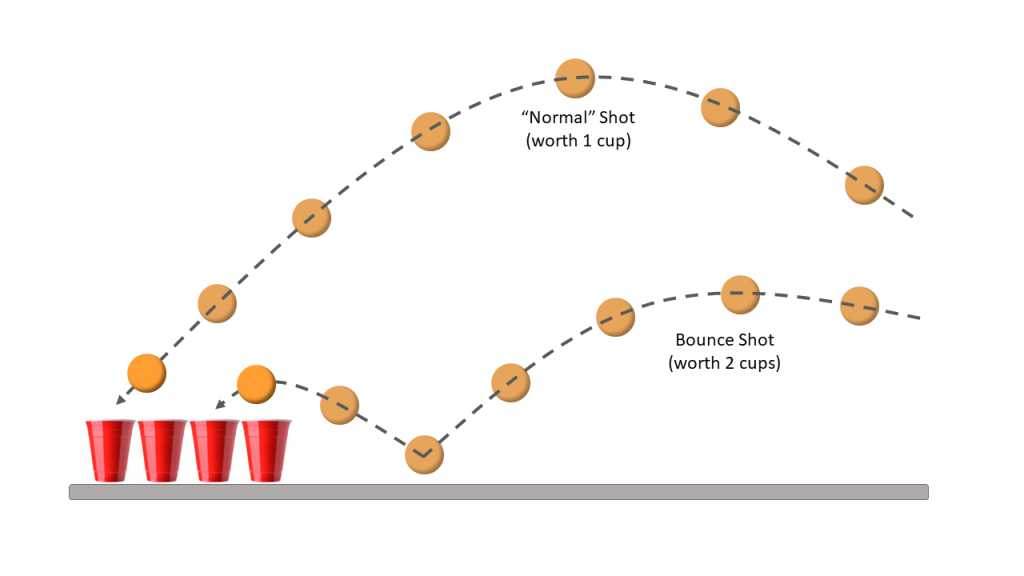
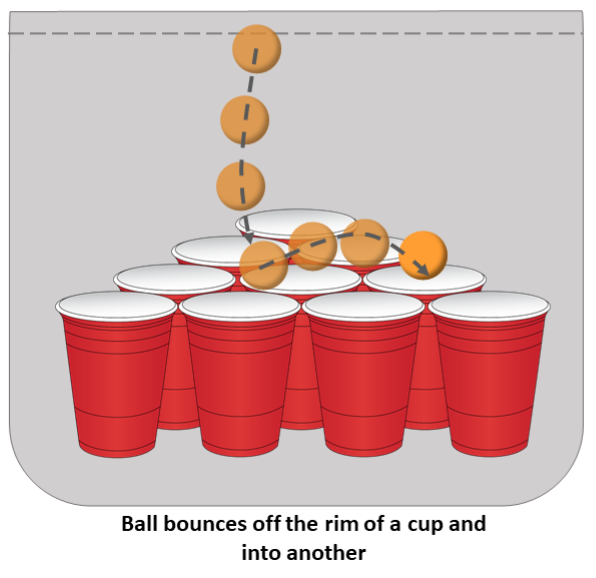
Celebrity Shot
Invite a spectator to take your shot instead. There is no additional benefit if this shot goes in – this rule is used to keep the game moving during bathroom breaks and to keep the audience engaged.
Trick Shot
Instead of shooting normally, get creative and add some difficulty to your shot (e.g., bounce it off the roof). If your trick shot lands in an opposition's cup, the opposition must drink that cup and one more of their choice. A trick shot can be defended after it has bounced on the table or a cup, and if successfully sunk, a trick shot cannot be used again that game.
An opposition player may challenge whether a trick shot was sufficiently difficult. If the audience agrees, or if the opposition can replicate the shot on their first attempt, the shot is void and the initial player must attempt a new trick shot.
Rebound shot
Any time you shoot and the ball bounces/rolls back across the table, your team can lunge to grab the ball. If you successfully grab the ball before it hits the ground, you are awarded an additional shot. You must take this shot as a trick shot, however, if you sink the ball, it is only worth one cup (instead of the normal two).
Balls back
If your team lands ALL of your shots in different cups (it is usually two shots, but can be more with abilities), balls back is triggered. The opposition drinks the appropriate number of cups, then your team receives two more shots (even if more than two balls were sunk initially).
Grenade AKA Explosion; Bomb
If your team lands ALL of your shots in the same cup, a grenade is triggered. The opposition must drink this cup and all cups that are touching it (i.e., directly adjacent). Balls back is not awarded when a grenade is triggered.

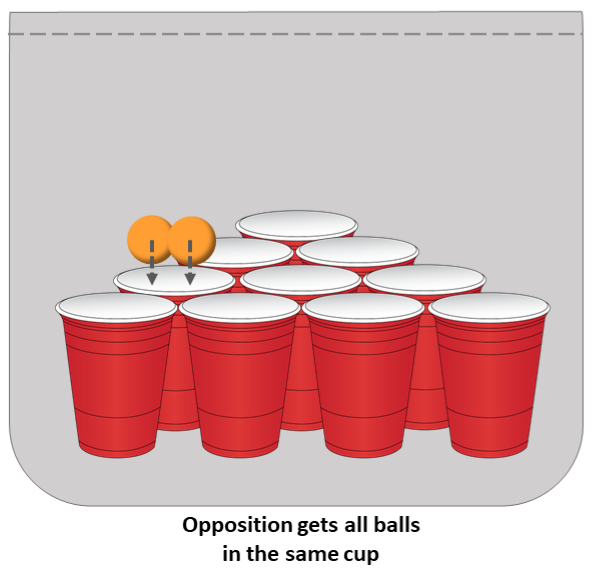
Some notes about balls back and grenades:
- If your team has three shots per turn, and you sink two in different cups (but miss the third), you do not receive balls back. Only those two cups are removed.
- If your team has three shots per turn, and you sink two in the same cup (but miss the third), you do not receive balls back nor a grenade. Only the one cup is removed.
- If your team has three shots per turn, and you sink two in the same cup and one in a different cup, both cups are removed andballs back is awarded.
- If your team has two shots per turn and you sink one, miss the second, but grab the ball and successfully sink a rebound shot, you do not receive balls back. Only those two cups are drunk.
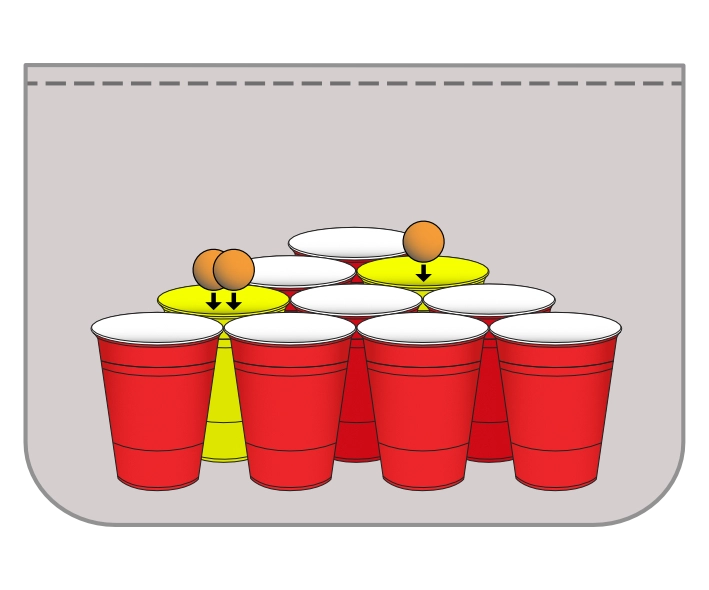
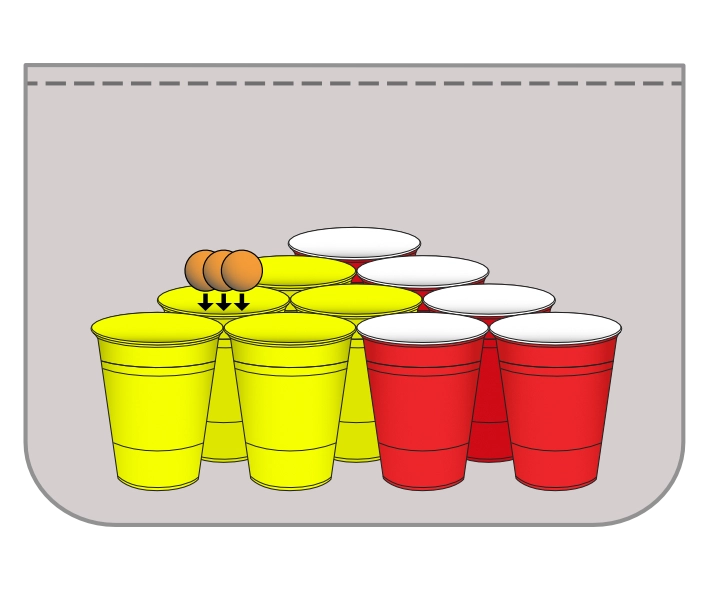
Other base rules
Re-rack AKA Re-arrange; re-formation
At the start of your turn, you can request that the opposition re-rack their cups. Unless otherwise specified, a re-rack can only be called when the opposition has 3 or 6 cups remaining (triangle numbers). If you choose to request one, your opposition must arrange their cups into a triangle pointing towards you. Some countries have unique re-racks, so read their abilities carefully.
There is no limit to the number ofre-racks you can call during a game, provided it meets the above rules.See also: Unrecommended house rules
Re-set
If cup/s are knocked out of position, you can ask for them to be re-set to the position they moved from. Though this should probably be done without needing to ask. Have some manners.
Redemption AKA Revenge; Rebuttal
Redemption is triggered when you sink the opposition’s last cup. Before this cup is removed, the opposition get a chance to continue the game by sinking a cup themselves. The number of chances they get is equal to the number of shots your team took that turn (i.e., if you shot twice, the opposition get two chances). If they successfully sink one of your cups, neither your cup nor their cup is removed, and the game continues starting with your turn. If they don't land a shot, you win!
If you sink all of your opposition’s cups but haven’t used all of your allocated shots, you may forfeit the remaining shots to give your opponent less chances at redemption. Alternatively, you can shoot your leftover shots, as you automatically win with noredemption if:
- a) a grenade is triggered and it removes all the opposition's remaining cups, or
- b) a balls back is triggered, and now you have no more cups to shoot at.
Note:Redemption is nota part of either team's turn. Therefore,re-racks cannot be called and, unless explicity stated, country abilities cannot be used.
Optional house rules
These rules should work regardless of what countries are played. Feel free to include these in your games:
Airball AKA Overs
If you shot misses the cups and table completely, the opposition can shout “airball!”, and you must forfeit all remaining shots on your turn.
Balling your own cups
If you drop a ball into your own cup (or slap it in, your trick shot falls in, etc.), it must be drunk immediately and you do not get to re-shoot.
Bitch cup AKA Death cup
If you sink a cup and it is not immediately drunk by the opposition (i.e., they hold it or set it aside) you may shoot for this ‘Bitch Cup.’ If you sink this cup, you automatically win. The opposition does not receive a redemption. Drink your cups.
Blowing the ball
The defending team may blow a ball out of a cup if it is spinning and has not yet touched the liquid in the bottom. If it is blown out, is dry (the opposition or a spectator can confirm this), and does not enter another cup it has been successfully defended. If it enters another cup, it counts for two and the defending team must drink both cups. Some also allow using fingers to scoop the ball out for the same effect.
Eyes
Instead of random chance, both teams can use skill to see who goes first. Set up 6 cups in a normal triangle and choose one person from each team. While maintaining full eye contact, both players shoot the ball at the same time. If both (or neither) player sinks a shot, their teammate then shoot with the same method. This continues until only one person gets a shot in, and that team starts first.
No refills
If you hit an opposition’s cup with a ball and it falls over, this counts as going in and the opposition must drink the remaining contents and remove it from the game. This rule prevents filling the cups up less than normal. However, if the ball is ditched to deliberately knock over the cup, the shot is void, the cup is refilled, and the player does not get to re-shoot. If there is confusion on the intended nature of the shot, consult a spectator, or re-take the shot.
No refills, part 2
If you knock over your own cups (such as, when trying to defend a bounce shot) they are not refilled and are removed from the game.
Unrecommended house rules
These rules are unbalanced or just aren’t practical. Keep these in regular beer pong.
Alternative re-racks
Instead of just triangle numbers (e.g., 3 and 6), you can re-rack the opposition’s cups at any point and into any shape. This doesn’t work with countries that have unique setups (e.g., Chile & Vietnam).
Island AKA Iso
Once per game, each player can choose an opposition’s cup that is by itself (touching no other cups), and call “island!”. If they then sink that cup on their first attempt, the opposition must drink it, and one more of their choice. This is unbalanced for countries that have cups that move closer, or are closer, to the centre of the table (e.g., Ecuador & Greece).
Heating up
If you sink a cup (on the opposition's side) two turns in a row, you can announce you are ‘heating up’. If you then sink a cup on your third turn in a row, you can shoot continuously until you miss. This doesn’t work if your country allows for numerous shots on the same turn (e.g., North Korea & Germany). We have instead included this mechanic as a standalone rule for Spain.
Ring of Fire
If you sink the centre cup and all three corner cups (leaving a ring), your team automatically wins with no redemption. How are you going to play Ring of fire against Greenland?
King Me AKA Miracle
If you shoot a ball and it balances on the rim of three cups, your team automatically wins with no redemption. How are you going to play King me against Paraguay?
Final disclosure
If you ever find yourself aruging over a technicality in the rules, come to an agreement with the opposition on what you think is fair, or ask a spectator. It's simply not worth hogging the table over (except if you have a trophy on the line – then ask the ref).
Lastly, this game has been balanced for what we think is an average player. Some abilities are, by design, strong in certain scenarios and weak in others. A good team should be able to win with any country. If you are finding that difficult, maybe you should be trying harder.
For further rule clarifications and FAQ's, click the button below.